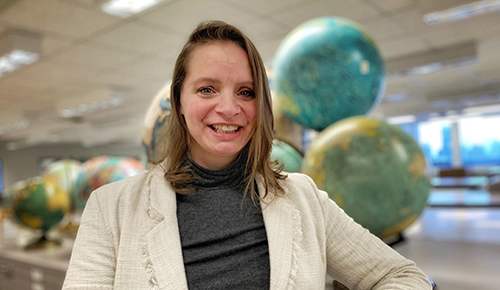
Postdoctoral fellow Charlene Nielsen is continuing to map adverse birth outcomes and potential environmental hazards in Canada as part of her research.
Charlene Nielsen grew up in a community where there was a zinc and lead smelter. When the air pollution was too high, she wasn't allowed to go outside to play. At the time, she didn't know she would eventually study the correlations between pollution and the impact on children's health.
As a postdoctoral fellow, Nielsen is continuing research that she started during an interdisciplinary PhD in both pediatrics and earth and atmospheric sciences. Nielsen, who is a geographer, focused on mapping adverse birth outcomes and potential environmental hazards in Canada.
She worked on the Data Mining and Neonatal Outcomes (DoMINO) project with a team of fellow graduate students from a number of departments and faculties, knowledge translation experts, under the supervision of Alvaro Osornio-Vargas in the Department of Pediatrics and Carl Amrhein in the Department of Earth and Atmospheric Sciences. Although adverse birth outcomes are a multi-factorial problem, the DoMINO research concluded that environmental factors were relevant based on location.
Nielsen's postdoc work is a natural progression of that research. "We still have a lot of questions and a lot of data. Luckily, we had the funding to continue. We want to be able to create an online atlas of the greater Edmonton area that maps pollution hotspots and could help address birth outcomes in those areas," says Nielsen.
The atlas will be used more immediately at the Children's Environmental Health Clinic in the Misericordia Community Hospital. When families ask how close their homes are to different sources of pollution, clinicians can show them on a map. The location also gives clinicians a starting point to decide if the child's allergy or respiratory problems are due to dust, pollen or something else in the air that they are breathing.
"Physicians need to be more aware of these kinds of potential risks in their patients' neighbourhoods. We can't see air pollution," she says.
Nielsen decided to complete a postdoctoral fellowship not only to continue this research, but because she wants to pursue an academic career. This opportunity has broadened her skills by supervising medical student research and providing a lecture in Osornio-Vargas' children's environmental health course.
"I love academic research and doing a postdoc is a sure way to continue this," says Nielsen.
Her fellowship ends in March but she has applied for additional funding to continue. She wants to look into links between pollution and multiple child health outcomes such as adverse birth outcomes, congenital heart disease, and childhood cancer.
As a postdoctoral fellow, Nielsen is continuing research that she started during an interdisciplinary PhD in both pediatrics and earth and atmospheric sciences. Nielsen, who is a geographer, focused on mapping adverse birth outcomes and potential environmental hazards in Canada.
She worked on the Data Mining and Neonatal Outcomes (DoMINO) project with a team of fellow graduate students from a number of departments and faculties, knowledge translation experts, under the supervision of Alvaro Osornio-Vargas in the Department of Pediatrics and Carl Amrhein in the Department of Earth and Atmospheric Sciences. Although adverse birth outcomes are a multi-factorial problem, the DoMINO research concluded that environmental factors were relevant based on location.
Nielsen's postdoc work is a natural progression of that research. "We still have a lot of questions and a lot of data. Luckily, we had the funding to continue. We want to be able to create an online atlas of the greater Edmonton area that maps pollution hotspots and could help address birth outcomes in those areas," says Nielsen.
The atlas will be used more immediately at the Children's Environmental Health Clinic in the Misericordia Community Hospital. When families ask how close their homes are to different sources of pollution, clinicians can show them on a map. The location also gives clinicians a starting point to decide if the child's allergy or respiratory problems are due to dust, pollen or something else in the air that they are breathing.
"Physicians need to be more aware of these kinds of potential risks in their patients' neighbourhoods. We can't see air pollution," she says.
Nielsen decided to complete a postdoctoral fellowship not only to continue this research, but because she wants to pursue an academic career. This opportunity has broadened her skills by supervising medical student research and providing a lecture in Osornio-Vargas' children's environmental health course.
"I love academic research and doing a postdoc is a sure way to continue this," says Nielsen.
Her fellowship ends in March but she has applied for additional funding to continue. She wants to look into links between pollution and multiple child health outcomes such as adverse birth outcomes, congenital heart disease, and childhood cancer.